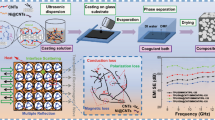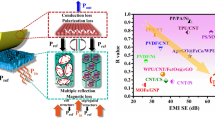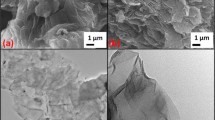Abstract
The incorporation of graphene-related materials as nanofiller can produce multifunctional foams with enhanced specific properties and density reduction. Herein we report on the preparation of microcellular thermoplastic polyurethane/graphene foams by batch foaming. Solution blending was first adopted to disperse graphene nanoplatelets (GNP) in the elastomeric matrix. Then, a foaming process based on the use of supercritical CO2 was adopted to produce the microcellular TPU/GNP composite foams with graphene content up to 1 wt%. The EMI shielding behaviour of the TPU/GNP foams has been assessed in the THz range, and has revealed their potential in comparison with other graphene-filled foams presented in the literature, that exhibit similar specific shielding effectiveness but at much higher content of graphene-related materials (10–30 wt%).





Similar content being viewed by others
Availability of data and material
Data are available from the corresponding author upon reasonable request.
References
Geetha S, Satheesh Kumar KK, Rao CRK, Vijayan M, Trivedi DC (2009) EMI shielding: methods and materials—a review. J Appl Polym Sci 112:2073–2086
Jiang D et al (2019) Electromagnetic interference shielding polymers and nanocomposites—a review. Polym Rev 59:280–337
Kim H, Abdala AA, Macosko CW (2010) Graphene/polymer nanocomposites. Macromolecules 43:6515–6530
Zhang H-B, Yan Q, Zheng W-G, He Z, Yu Z-Z (2011) Tough grapheme–polymer microcellular foams for electromagnetic interference shielding. ACS Appl Mater Interfaces 3:918–924
Yang Y, Gupta MC, Dudley KL, Lawrence RW (2005) Novel carbon nanotube-polystyrene foam composites for electromagnetic interference shielding. Nano Lett 5:2131–2134
Yang Y, Gupta MC, Dudley KL, Lawrence RW (2005) Conductive carbon nanofiber-polymer foam structures. Adv Mater 17:1999–2003
Thomassin J-M, Pagnoulle C, Bednarz L, Huynen I, Jerome R, Detrembleur C (2008) Foams of polycaprolactone/MWNT nanocomposites for efficient EMI reduction. J Mater Chem 18:792–796
Shen B, Zhai W, Lu D, Zheng W, Yan Q (2012) Fabrication of microcellular polymer/graphene nanocomposite foams. Polym Int 61:1693–1702
Salzano de Luna M et al (2019) Nanocomposite polymeric materials with 3D graphene-based architectures: from design strategies to tailored properties and potential applications. Prog Polym Sci 89:213–249
Spontak RJ, Patel NP (2000) Thermoplastic elastomers: fundamentals and applications. Curr Opin Colloid Interface Sci 5:333–340
Lan Y et al (2016) Electrically conductive thermoplastic polyurethane/polypropylene nanocomposites with selectively distributed graphene. Polymer 97:11–19
Cataldi P, Ceseracciu L, Marras S, Athanassiou A, Bayer IS (2017) Electrical conductivity enhancement in thermoplastic polyurethane-graphene nanoplatelet composites by stretch-release cycles. Appl Phys Lett 110:121904
Liu H et al (2016) Electrically conductive thermoplastic elastomer nanocomposites at ultralow graphene loading levels for strain sensor applications. J Mater Chem C 4:157–166
Liu H et al (2016) Organic vapor sensing behaviors of conductive thermoplastic polyurethane–graphene nanocomposites. J Mater Chem C 4:4459–4469
Nasr Esfahani A, Katbab A, Taeb A, Simon L, Pope MA (2017) Correlation between mechanical dissipation and improved X-band electromagnetic shielding capabilities of amine functionalized graphene/thermoplastic polyurethane composites. Eur Polym J 95:520–538
Ge C, Wang S, Zheng W, Zhai W (2018) Preparation of microcellular thermoplastic polyurethane (TPU) foam and its tensile property. Polym Eng Sci 58:E158–E166
Chen Y, Li Y, Xu D, Zhai W (2015) Fabrication of stretchable, flexible conductive thermoplastic polyurethane/graphene composites via foaming. RSC Adv 5:82034–82041
Di Maio E, Kiran E (2018) Foaming of polymers with supercritical fluids and perspectives on the current knowledge gaps and challenges. J Supercrit Fluids 134:157–166
Liu H et al (2017) Lightweight conductive graphene/thermoplastic polyurethane foams with ultrahigh compressibility for piezoresistive sensing. J Mater Chem C 5:73–83
Jiang Q et al (2019) Flexible thermoplastic polyurethane/reduced graphene oxide composite foams for electromagnetic interference shielding with high absorption characteristic. Compos A Appl Sci Manuf 123:310–319
Tammaro D, Contaldi V, Carbone MGP, Di Maio E, Iannace S (2015) A novel lab-scale batch foaming equipment: the mini-batch. J Cell Plast 52:533–543
Casini R, Papari G, Andreone A, Marrazzo D, Patti A, Russo P (2015) Dispersion of carbon nanotubes in melt compounded polypropylene based composites investigated by THz spectroscopy. Opt Express 23:18181–18192
Papari GP et al (2017) Morphological, structural, and charge transfer properties of F-doped ZnO: a spectroscopic investigation. J Phys Chem C 121:16012–16020
Ramirez D, Jaramillo F (2018) Improved mechanical and antibacterial properties of thermoplastic polyurethanes by efficient double functionalization of silver nanoparticles. J Appl Polym Sci 135:46180
Malard LM, Pimenta MA, Dresselhaus G, Dresselhaus MS (2009) Raman spectroscopy in graphene. Phys Rep 473:51–87
Mates JE et al (2015) Durable and flexible graphene composites based on artists’ paint for conductive paper applications. Carbon 87:163–174
Cataldi P et al (2018) Sustainable electronics based on crop plant extracts and graphene: a “bioadvantaged” approach. Adv Sustain Syst 2:1800069
Dong S, Shi Q, Huang W, Jiang L, Cai Y (2018) Flexible reduced graphene oxide paper with excellent electromagnetic interference shielding for terahertz wave. J Mater Sci Mater Electron 29:17245–17253
Huang Z et al (2018) Ultra-broadband wide-angle terahertz absorption properties of 3D graphene foam. Adv Func Mater 28:1704363
Liu L, Das A, Megaridis CM (2014) Terahertz shielding of carbon nanomaterials and their composites—a review and applications. Carbon 69:1–16
Shen B, Li Y, Zhai W, Zheng W (2016) Compressible graphene-coated polymer foams with ultralow density for adjustable electromagnetic interference (EMI) shielding. ACS Appl Mater Interfaces 8:8050–8057
Ling J, Zhai W, Feng W, Shen B, Zhang J, Zheng W (2013) Facile preparation of lightweight microcellular polyetherimide/graphene composite foams for electromagnetic interference shielding. ACS Appl Mater Interfaces 5:2677–2684
Li Y, Pei X, Shen B, Zhai W, Zhang L, Zheng W (2015) Polyimide/graphene composite foam sheets with ultrahigh thermostability for electromagnetic interference shielding. RSC Adv 5(31):24342–24351
Pupeza I, Wilk R, Rutz F, Koch M (2007) Highly accurate material parameter extraction from THz time domain spectroscopy data. In: Conference on lasers and electro-optics/quantum electronics and laser science conference and photonic applications systems technologies. Optical Society of America
Acknowledgements
This activity has received funding from the European Union's Horizon 2020 research and innovation programme under Grant Agreement No GrapheneCore3 881603. The authors acknowledge also the financial support of the National Institute for Nuclear Physics (INFN) under the project “TERA”.
Funding
This study was funded by EU (Graphene Core 3 Grant Number 881603) and by INFN (project TERA).
Author information
Authors and Affiliations
Corresponding author
Ethics declarations
Conflict of interest
The authors declare that they have no conflict of interest.
Additional information
Publisher's Note
Springer Nature remains neutral with regard to jurisdictional claims in published maps and institutional affiliations.
Rights and permissions
About this article
Cite this article
Pastore Carbone, M.G., Beaugendre, M., Koral, C. et al. Thermoplastic polyurethane–graphene nanoplatelets microcellular foams for electromagnetic interference shielding. Graphene Technol 5, 33–39 (2020). https://doi.org/10.1007/s41127-020-00034-0
Received:
Revised:
Accepted:
Published:
Issue Date:
DOI: https://doi.org/10.1007/s41127-020-00034-0




